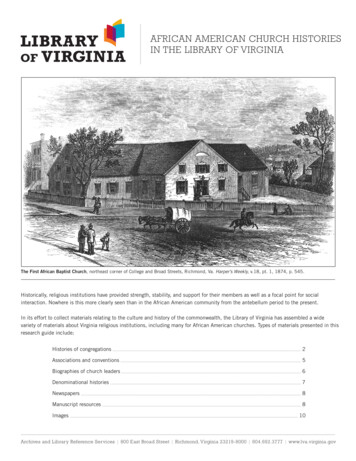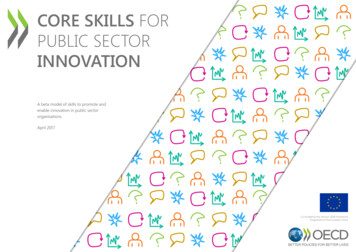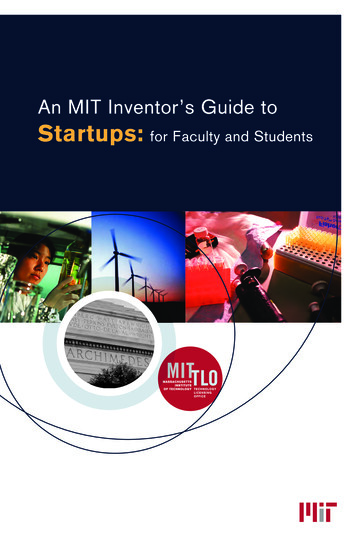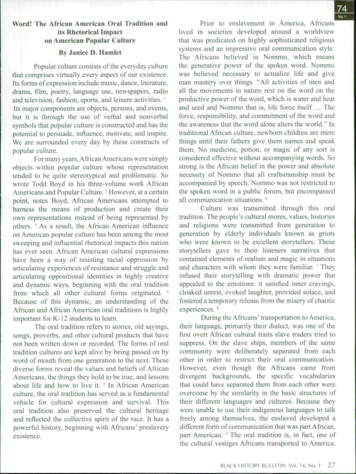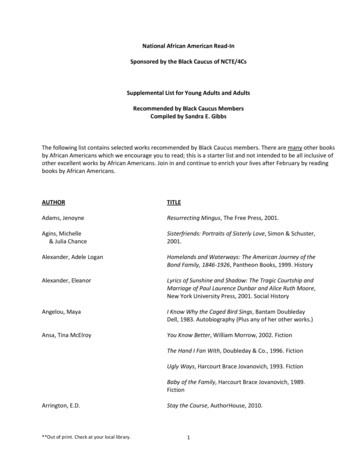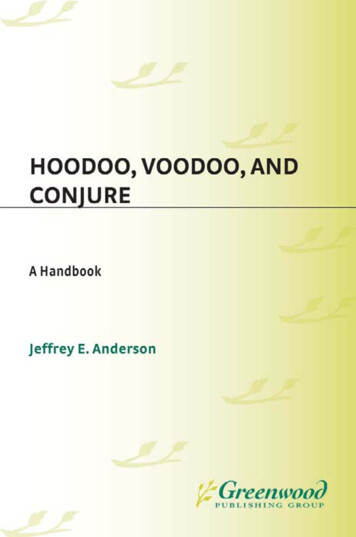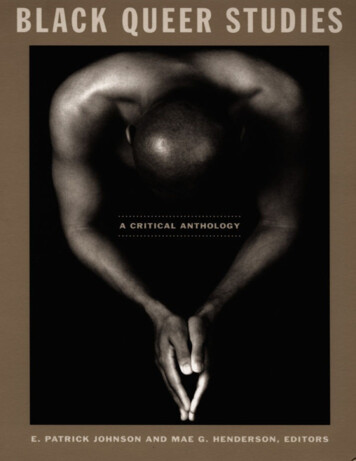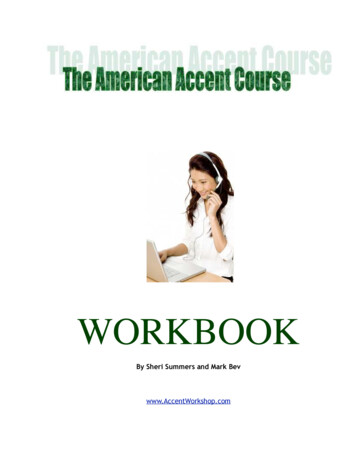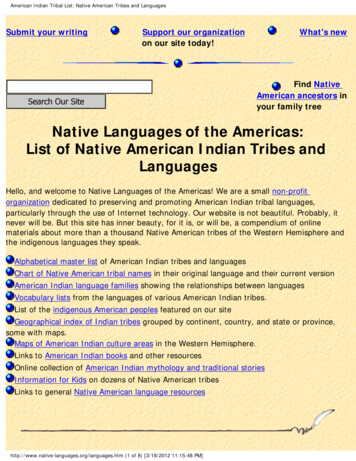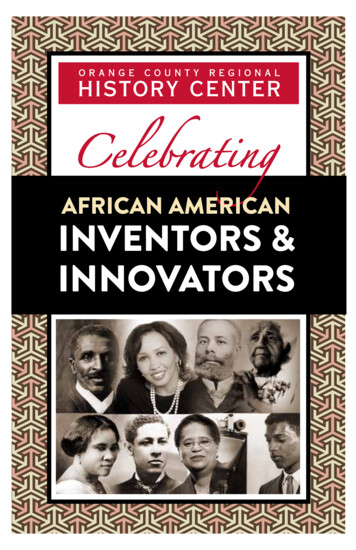
Transcription
CelebratingAFRICAN AMERICANINVENTORS &INNOVATORS
We’d like to introduce you to some peoplewho truly made historyThe Orange County Regional History Center is proud topresent these stories of African American inventors andinnovators. Some of them lived a long time ago, and someare still working among us. Some grew up or worked in CentralFlorida. All used their creativity to improve the lives of Americans inevery walk of life. We hope these brief biographies will inspire youto learn even more about them, and about the many other AfricanAmerican trailblazers throughout our history.Michael PerkinsHistory Center ManagerContentsJanet Emerson Bashen. 3Dr. Patricia Bath. 4Miriam Benjamin. 5Henry Blair. 6Sarah Boone . 7Marie Van Brittan Brown. 8George Carruthers. 9George Washington Carver. 10Bessie Coleman. 11Mark Dean. 12Dr. Charles Richard Drew. 13Ellen F. Eglin. 14Thomas Elkins. 15Sylvester James Gates, Jr. 16Sarah E. Goode. 17Meredith Gourdine. 18Talbert T. Gray. 192Bessie Blount Griffin. 20Zora Neale Hurston. 21Shirley Ann Jackson. 22Thomas Jennings. 23Lonnie G. Johnson. 24Frederick Jones. 25Marjorie Joyner. 26Lewis Latimer. 27Jan E. Matzeliger. 28Elijah McCoy. 29Garrett Morgan. 30Alice H. Parker. 31Richard Spikes. 32Madam C.J. Walker. 33James E. West. 34To Learn More. 35Celebrating African American Inventors & Innovators
Janet Emerson BashenBorn in Ohio, 1957Software inventor who blazed trails in businessJanet Emerson Bashen is the first AfricanAmerican woman to hold a software patent.In 1994, she began her own business,working at her kitchen table in her Texas home.She wanted to help people who had not beentreated fairly at their jobs because of their skincolor or religion, or other reasons. Now theBashen Corporation is well known across thecountry. It has helped thousands of people, andJanet has received many honors. Janet was born in Ohio. Her family moved to Huntsvillein Alabama when she was a little girl. Her dad worked hard as a garbagecollector. Her mom was the first African Americanemergency-room nurse in Huntsville. Janet studied law and government incollege in Texas, where she still lives. Her web-based software invention,LinkLine, made it much easier to makeand track equal employment opportunityclaims.“My successesand failuresmake me whoI am, and whoI am is a blackwoman raisedin the South byworking-classparents whotried to give mea better life byfosteringa ferventcommitmentto succeed.”Orange County Regional History Center3
Dr. Patricia BathBorn in New York City, 1942Doctor and laser scientist whohelped people see betterIn 1986, Dr. Patricia Bath invented a laser tool,the Laserphaco Probe, that has helped improveor restore vision in patients around the world.She was the first African American woman doctor toreceive a medical patent.Patricia also has worked hard to bring eye careto people who did not have much money to visitdoctors and get treatment. She co-founded theAmerican Institute for the Prevention of Blindness,which is dedicated to the idea that “eyesight is abasic human right.” Patricia was born in Harlem, in New YorkCity, where she grew up. Her dad was the first black motorman onthe New York subway system. Her interest in science grew after her mombought her a chemistry set. Patricia completed high school in twoyears. She finished medical school in 1968. She was the firstAfrican Americandoctor to completea residency inophthalmology. Anophthalmologist is adoctor who treats eyeproblems.4Celebrating African American Inventors & Innovators“The ability torestore sightis the ultimatereward.”
Miriam BenjaminBorn in South Carolina, 1861Teacher whose signaling inventionwas used in CongressMiriam Benjamin was a schoolteacher inWashington, D.C., more than 100 yearsago when she got the idea for her invention. Some restaurants in the city were large, andMiriam wanted to make it easier for people to call awaiter without having to wave or snap their fingers.She designed a chair with a button to buzz the waiters’ station, and a light to show which guest neededhelp. Miriam’s signal system was even used in theU.S. House of Representatives. Miriam was born in Charlestonduring the Civil War, but herfamily moved to Boston whenshe was 12. Miriam was the second AfricanAmerican woman to receive a patent,in 1888. Miriam’s brothers were also inventors.Her brother Edgar invented thebicycle clip. Her invention led the way for thebuttons used to call flightattendants on airplanes.Orange County Regional History Center5
Henry BlairBorn in Maryland, 1807Farmer who helped plant corn and cottonseeds much fasterHenry Blair was the second AfricanAmerican to be issued a patent, in 1834.He was a farmer in Maryland a longtime ago – he was born more than 200 years ago.Henry couldn’t read or write, but he was verysmart. He figured out how to a make a machinethat allowed farmers to plant corn seeds muchfaster and with less labor. He estimated that hisinvention did the work of eight men. Henry was born in Glen Morgan,Maryland, and he died in 1860, beforethe Civil War. Henry couldn’t read and write. Whenhe applied for his patent, he signedwith an X. He also received a patent for a cottonplanter.6Celebrating African American Inventors & InnovatorsHenry Blairclaimed hisseed-plantingmachine coulddo the work ofeight men.
Sarah BooneBorn in North Carolina, 1832Dressmaker who made it easier to iron clothesSarah Boone was a dressmaker at a time whenwomen’s clothes had fancy long sleeves and long,full skirts. Ironing fabric was very important inher work, and the ironing boards she used didnot work as well as she wanted – especially whenit came to ironing long sleeves. Sarah created aspecial ironing board that was narrow and curvedso that a sleeve could be fitted over it. Shereceived a patent for her ironing board in 1892. Sarah Boone was born near New Bern inNorth Carolina. Her name was Sarah Marshall before shemarried James Boone, a brick mason. Sarah and James moved their family toNew Haven in Connecticut before theCivil War began in 1861. They had eightchildren. James died in 1874, a long time beforeSarah did. She lived until 1904. During Sarah’s time,people used heavy ironsthat were heated on thestove. Electric irons werepatented in 1880 but werenot used very much untilthe 1900s.Orange County Regional History Center7
Marie Van Brittan BrownBorn in Queens, New York City, 1922Nurse who pioneered the home-security systemMarie Van Brittan Brown was a nurse inthe 1960s when she got the idea forher invention. Marie worked nightsin the New York City neighborhood of Jamaica,Queens. She thought a new kind of audio-visualalarm would help people feel more safe at home,especially late at night. Marie and her husband,Albert, created an alarm system that allowedher to see who was at the front door from thebedroom of their house. The Browns received apatent in 1969. Marie and Albert’s security systemused a motorized camera, atwo-way microphone, and avideo monitor. The invention could alsolock and unlock the frontdoor and sound an alarm. The Browns’ work receivedawards and an article inThe New York Times. Marie’s idea inspired thesecurity systems we havetoday. In later patents, atleast thirteen other inventorssaid they had relied on theBrowns’ 1960s invention.8Celebrating African American Inventors & Innovators
George CarruthersBorn in Ohio, 1939Scientist who helped reveal themysteries of spaceGeorge Carruthers created a special camerathat was used in 1972 during the Apollo 16flight to the moon. His invention is calledthe “Far Ultraviolet Camera/Spectrograph.” It letscientists learn a lot about the earth’s atmosphere.The camera also allowed scientists to see ultraviolet images of more than 550 stars, nebulae, andgalaxies. George was awarded NASA’s ExceptionalScientific Achievement Medal for this project. Healso developed other inventions, including a camerathat captured an image of Halley’s Comet. George built his first telescope when hewas only 10 years old. His dad was an engineer who encouragedGeorge’s interest in science. George’s dad died when George was 12.His mom moved the family toChicago. In high school, George wonfirst prize at a science fair foranother telescope he built. George became a physicist ata center for space research inWashington, D.C. He was awarded the NationalMedal of Technology andInnovation by PresidentObama.“Startpreparingearly. Take allthe scienceand mathcourses.Emphasizethe basics.”Orange County Regional History Center9
George Washington CarverBorn in Missouri, 1864Botanist and teacher who changed farming inthe SouthGeorge Washington Carver was one of the most importantand respected scientists of his day. Even President TheodoreRoosevelt asked for his advice. George was a botanist (anexpert on plants) who taught at the Tuskegee Institute in Alabama.He told farmers to rotate their crops instead of growing the samething year after year. George’s advice was badly needed in the South,because the land was worn out from growing cotton, which drainsthe soil of nutrients. George told farmers to plant cotton one yearand change to soil-enriching peanuts or sweet potatoes the next year.Farmers followed his advice with great success. George Washington Carver was born to enslaved parentson a plantation owned by Moses and Susan Carver. Theexact date of his birth isn’t known. He was orphaned when he was a baby and was raised bythe Carvers. He developed more than 300 uses for peanuts, includingink and cooking oil. George didn’t really invent peanutbutter, as many people believe, buthe did help it become popular. In 1943, George’s birthplace inMissouri was declared a U.S.National Monument. It was the firstdedicated to an African American.“When you can do the common things oflife in an uncommon way, you will commandthe attention of the world.”10 Celebrating African American Inventors & Innovators
Bessie ColemanBorn in Texas, 1892Pioneering pilot who thrilled audiences andinspired young peopleBessie Coleman was the first AfricanAmerican woman to earn an internationalpilot’s license, in 1921. When U.S. flightschools turned her down, Bessie went to Franceand learned to fly at a famous school for pilots.Flying was new and exciting in the 1920s, andair shows were popular. Bessie became a rockstar flyer at shows all over the country. She alsogave inspiring lectures. During a speaking tourin Florida, Bessie became friends with an Orlandocouple, Rev. Hezekiah K. Hill and his wife, Viola.She stayed with them in Orlando on WestWashington Street. A section of the street is nownamed for her. Bessie’s parents worked as sharecroppers.Her father was part Native American. She moved to Chicagoand learned storiesabout World War Ipilots from her olderbrothers. She wanted tofly, too. Mae Jemison, the firstAfrican American femaleastronaut in space,carried a picture ofBessie during Mae’s firstmission, in 1992.“I refused totake ‘no’ for ananswer.”Orange County Regional History Center11
Mark DeanBorn in Tennessee, 1957Scientist and inventor who helped launchthe personal-computer ageMark Dean was one of the original inventorsof the IBM personal computer, whichchanged the way people work in a bigway. He helped develop the color PC monitorand also created the technology that allowsdevices such as the mouse and keyboard to beplugged into computers and communicate withone another. Mark also managed the team thatcreated the one-gigahertz processor chip. He’s amember of the National Inventors Hall of Fameand the National Academy of Engineers. Mark grew up in Jefferson City, Tennessee. When he was a boy, Mark built a tractorfrom scratch with the help of his dad. He excelled in school and sports. In 1979, Mark graduated from theUniversity of Tennessee, where hestudied engineering. Not long after college, Mark landed a jobat IBM. He holds three PC patents forbeing the co-creator of the IBM personalcomputer released in 1981. Mark continued to go to school andlearn more. He earned a master’s degreefrom Florida Atlantic University and adoctorate from Stanford University, bothin electrical engineering.12 Celebrating African American Inventors & Innovators“A lot of kidsgrowing uptoday aren’ttold that youcan bewhatever youwant to be. . . .There may beobstacles, butthere are nolimits.”
Dr. Charles Richard DrewBorn in Washington, D.C., 1904Doctor who pioneered America’s firstlarge-scale blood bankIn the late 1930s, Dr. Charles Drew inventeda way to preserve blood plasma, allowing it tobe stored and shipped for blood transfusions.Until Charles’s discoveries, blood was perishableand not fit for use after about a week. He becamethe leading expert on storing blood. Charles’swork was even more important during WorldWar II. Before the United States entered the war,he oversaw blood banks to help British soldierswho were wounded. In 1941, Charles becamethe medical director of the American Red CrossNational Blood Donor Service. He organized thecollection of blood donations to help Americantroops. It was the first mass blood-collectionprogram of its kind. Charles was an excellent athlete and wasonce ranked among the five best hurdlersin the United States and almost went tothe Olympics. During World War II, the U.S. ArmedForces still kept blood from black andwhite donors separate. Charles spokeout against this practice and theignorance behind it. When the policy wasn’t changed, Charlesresigned. He returned to teaching atHoward University, where he was aninfluential teacher and role model.“Here we havewhat rarelyhappens inhistory, a lifewhich crowdsinto a handfulof yearssignificance sogreat, men willnever forget it.”– Dr. MordecaiJohnson, formerpresident ofHowardUniversity,about Dr.Charles DrewOrange County Regional History Center13
Ellen F. EglinBorn in Washington, D.C., 1849Housekeeper and inventor who made washingclothes much easierEllen F. Eglin made her living as a housekeeper a long time ago, in the 1880s,when there were not a lot of ways to washclothes, except with your hands. Ellen invented amachine that had two rollers in a frame that wasconnected to a crank. When you were doinglaundry, you could put the clothes between therollers after you scrubbed them in a wash basin.Ellen’s clothes wringer made it much easier tosqueeze water, soap, and dirt out of the clothes.Similar machines were used in England beforeEllen’s invention, but no one in America knewthey existed. During Ellen’s lifetime in the 19thcentury, she was one of only a fewAfrican American women inventors. She helped set the stage for laterinventors such as MadamC.J. Walker, as well as SarahBoone. Ellen went on to work as aclerk in a census office. She should have made alot of money from herinvention, but she sold therights to it for 18 withoutpatenting it.14 Celebrating African American Inventors & Innovators
Thomas ElkinsBorn in New York, early 1800sHis patents included an early refrigeratorand a fancy toiletThomas Elkins was a respected pharmacistin Albany, New York, who thought a lotabout how to make people’s lives betterthrough inventions. He received his first patentin 1870 for a folding dining table that could alsobe used as an ironing board and a quilting frame,too. Thomas invented another interesting pieceof furniture called a “chamber commode” thatincluded a bureau, mirror, book rack, washstand,table, easy chair, and even a toilet. His mostuseful invention was a kind of early refrigeratorthat used metal coils, cooled by ice, to surroundfood and help keep it from spoiling. In addition to his inventions, Thomaswas an abolitionist, which meantsomeone who opposed slavery. Thomas was the secretary of theVigilance Committee in Albany, oneof many abolitionist groups formedin the North in the 1840s. He and other abolitionists offeredfood, clothing, money, and jobs tohelp enslaved people achieve theirfreedom.Orange County Regional History Center15
Sylvester James Gates, Jr.Born in Tampa, 1950Renowned scientist who helps peopleunderstand our universeSylvester James Gates is a trailblazingphysicist and National Medal of Sciencewinner. He was born in Tampa, but he grewup in the Parramore neighborhood of Orlando.His friends and family call him “Jim.” You mighteven have seen him on television – he has beenon PBS programs such as “Nova.” In a 2016TV commercial, he appears as himself, helpinga young man understand that “you don’t haveto be a brainiac” to do your own taxes. Peopledo think of Jim as a “brainiac,” but you wouldfind him very easy to talk with. Like the famousscientist Albert Einstein, Jim does work to help usunderstand the structure of our universe. Instead of thinking of particles to explainour world, Jim says everythingmay be made of very tiny piecesof string that vibrate back andforth, like guitar strings. That way of looking at the universe is called string theory. Every year, a student at JonesHigh School receives a 1,000award for excellence in mathand science that’s named forJim. He has delivered the prize inperson every year since 2004.16 Celebrating African American Inventors & Innovators“When youdecide to dosomething withyour mind, itopens doors.”
Sarah E. GoodeBorn in Ohio, about 1850First African American woman toreceive a U.S. patentSarah’s original name was Sarah ElizabethJacobs. She was born into slavery butbecame a free woman after the Civil War.Sarah moved to Chicago, where she met herfuture husband, Archibald Goode. He was acarpenter, and after they were married, theyopened a furniture store and were very successful.Many of Sarah’s customers lived in small apartments in the big city. They did not have verymuch room in their homes for furniture. To helpthem, Sarah designed a special piece of furniture.At night, it could be folded out to make a fullsize bed. During the day, you could fold it up tobe a desk – two pieces of furniture in one. Sarah received the patent for her cabinetbed on July 14, 1885. Her invention led theway for furniture suchas the Murphy bed. Thiskind of bed is also calleda wall bed or pull-downbed. It can be stored flatagainst the wall or in acabinet during the day,to save space in a smallhome.Orange County Regional History Center17
Meredith GourdineBorn in New Jersey, 1929Scientist who invented a way to removesmoke and fogMeredith Gourdine was a physicist andengineer who pioneered research aboutsomething called electrogasdynamics,or EGD. Meredith discovered that electricitycan be used to help control both smoke and fog.The system he invented removes smoke frombuildings after a fire and makes the air safe forpeople again. Meredith’s methods also helpedmake airports safer by clearing fog from runways.Applying the principles of EGD, Meredith alsodiscovered ways to remove the salt from sea waterand reduce pollutants in smoke. At the time of hisdeath in 1998, he held more than 30 patents. Meredith grew up in Brooklyn in NewYork City. He served as an officer in the U.S. Navybefore he earned his Ph.D. Meredith was also a star athlete. Whenhe was in college at Cornell University,he earned the nickname “Flash” as atrack champion. He won a silver medal in the long jumpin the 1952 Olympics in Helsinki,Finland.18 Celebrating African American Inventors & Innovators
Talbert T. GrayMedia pioneer and the first African AmericanTV newsman in FloridaWhen Talbert T. Gray joined WESH-TVin Orlando in 1969, he became thefirst black newsman on a commercialstation in Florida. In a long career in TV,newspapers, magazines, and radio, Talbert blazedtrails and opened doors, changing media in theSouth forever. He also published the firstAfrican American magazine to celebratediversity in Central Florida and hosted a talkshow on public television station WMFE-TV.Talbert now lives in North Carolina. Talbert went to high school in Memphis,in Tennessee. He married his wife, Mary Ann, in 1965. Talbert was in the U.S. Navy,and was stationed at Orlando’sNaval Training Station. On Talbert’s TV talk show inOrlando, he interviewed civilrights pioneers such as theRev. Ralph Abernathy, andother famous people. He also created a newspaperand managed a radio station. Talbert has received manyawards for this trailblazingcareer.“A songwriteronce wrote,‘If I can helpsomebody asI pass along aword or song,then my livingshall not be invain.’ ”Orange County Regional History Center19
Bessie Blount GriffinBorn in Virginia, 1914Inventor who helped injured soldiers and laterbecame a forensic scientistBessie Blount was a physical therapist whohelped soldiers who were badly hurtduring World War II and the KoreanWar. Some of the soldiers were paralyzed.Bessie produced new, effective methods in herwork with the soldiers. She invented a device thathelped even paralyzed soldiers feed themselves.In 1951, she received a patent for it. Bessie madea number of other inventions. She had a veryinteresting life in other areas, too. In the 1970s,she had a second career as a forensic scientist,helping police solve crimes through scientifictechniques and tests. Bessie studied nursing at the CommunityKennedy Memorial Hospital in Newark,N.J., a hospital owned by AfricanAmericans. She studied modern dance, which helpedher in her physical therapy work. In her forensic science career, Bessiewas an expert on forgeries and fakedocuments. She became chief examiner for thepolice in Portsmouth, Virginia. In 1977, Bessie became the firstAfrican American woman to train andwork at Scotland Yard, the famouspolice force in London. She was 63.20 Celebrating African American Inventors & Innovators“A blackwoman caninventsomething forthe benefit ofhumankind.”
Zora Neale HurstonBorn in Alabama, 1891Path-breaking author who also pioneered in thescience of anthropologyZora Neale Hurston is a famous authorwho wrote novels including “Their EyesWere Watching God,” which inspired amovie produced by Oprah Winfrey. Every year aweek-long festival in Eatonville celebrates Zora’slegacy. Many people don’t know that Zora wasalso a pioneering anthropologist. Anthropologyis the science of the origins and development ofhuman beings and their cultures. Zora was thefirst African American woman to graduate fromBarnard College in New York City, in 1928. Shestudied with a teacher named Franz Boas, who isnow called the father of American anthropology. Zora was born in Alabama, but she grewup in Eatonville, Florida, which shealways called her hometown. In her writing, Zora used the skills shelearned studying anthropology. In 1936 and 1937, Zora received agrant to study the people ofJamaica and Haiti. She wrote all about her adventuresin a book called “Tell My Horse:Voodoo and Life in Jamaica andHaiti” (1938). Zora even wrote about the subjectof zombies in her book.“Research isformalizedcuriosity. Itis poking andprying with apurpose.”Orange County Regional History Center21
Shirley Ann JacksonBorn in Washington, D.C., 1946First African American woman to lead a majorresearch universityPhysicist Shirley Ann Jackson is the firstAfrican American woman to earn herPh.D. from the Massachusetts Institute ofTechnology (MIT), one of the world’s topuniversities in science and engineering. She wasalso the first black woman president of theAmerican Association for the Advancement ofScience, and the first woman and AfricanAmerican to chair the U.S. Nuclear RegulatoryCommission. Shirley is now president ofRensselaer Polytechnic Institute in New York, ourcountry’s oldest technological research university.She encourages students to break into science,technology, engineering, and math. Shirley’s interest in science began whenshe was a little girl. She loved to studythe bumblebees in her backyard. Shirley and her sister, Gloria, also builtsoapbox racing cars when they were kids. Her scientific discoveries helped lead tothe invention of the touchtone telephone, as well ascaller ID and call waiting.22 Celebrating African American Inventors & Innovators“Aim for thestars, so thatat least youcan reach thetreetops.”
Thomas JenningsBorn in New York City, 1791Tailor and businessman who inventeddry cleaningThomas Jennings was the first AfricanAmerican to receive a patent, in 1821 –almost 200 years ago. Thomas was a tailorin New York City. He made clothes such as pantsand suits for men, and became very successful.Thomas opened a clothing shop that grew intoone of the city’s largest. In those days, men’ssuits were made of wool and other fabrics thatwere not easy to clean. When his customers askedThomas for advice on removing stains on theirclothes, he tried out various cleaners andmethods. Thomas came up with a process calleddry-scouring and added the service of drycleaning clothes to his business. Thomas’s tailoring skills were so goodthat people came from far away to havehim make their clothes. People who were held in slavery were notable to hold a patent in Thomas’s time. Because he was a free man, Thomas wasable to have exclusive rights to hispatent and to profit from it. Thomas prospered through hisskills and his invention. He usedmost of his money to free familymembers who were enslaved and tosupport the end of slavery.Orange County Regional History Center23
Lonnie G. JohnsonBorn in Alabama, 1949NASA engineer who also invented theSuper Soaker water gunSpace scientist Lonnie G. Johnson workedfor NASA on the Galileo mission to Jupiter,the Mars Observer project, and the Cassinimission to Saturn. He earned many awards for hisspacecraft-control systems, but he may be knownbest as the inventor of a popular toy: the SuperSoaker water gun. Lonnie got the idea for it whilehe was working on an eco-friendly heat pumpand accidentally shot a stream of water across theroom. The Super Soaker’s success allowed him tostart his own company and do research in greentechnology. Lonnie holds more than 100 patents.He lives in Atlanta. In high school, Lonnie built a 4-foot-tallrobot that was remote-controlled. Lonnie served in the U.S. AirForce after college at TuskegeeUniversity. Lonnie worked for several yearsperfecting his accidental invention,the Super Soaker, before he sold itto a toy company in 1989. It is still a very popular toy andhas earned Lonnie millions ofdollars.24 Celebrating African American Inventors & Innovators“People tellme what greattimes they havewith the waterguns.”
Frederick JonesBorn in Ohio, 1893Inventor who pioneered refrigeration in trucks,ships, and railway carsFrederick Jones invented the first automaticrefrigeration unit for trucks. His workmeant that food could be moved longdistances without spoiling. The technologyFrederick developed was adapted to ships andrailway cars. His invention was very important. Itmeant that crops and frozen food could be soldto faraway places. Frederick’s work was also veryhelpful during World War II, because it allowedblood serum and medicines to be transportedinto the battlefields. He also invented a portablex-ray unit that was used during World War II.Altogether Frederick held more than 60 patents. Frederick had a hard childhood and didnot have much education. In 1912, he moved to Minnesota andworked as a mechanic on a large farm. Frederick was very interested inmechanics and worked hard toteach himself about it. He alsotaught himself electronics. Frederick invented the firstdevice that let movie projectorsplay sound. He co-founded the company thatbecame Thermo King. It is theworld leader in temperaturecontrol equipment for transport.Orange County Regional History Center25
Marjorie JoynerBorn in Virginia, 1896Beauty-industry pioneer who invented thepermanent-wave machineIn 1916, Marjorie Joyner opened a beautysalon in Chicago and soon met Madam C.J.Walker, a leader in beauty products (see Page33). Marjorie had a long career with the WalkerCompany and became the director of its nearly200 beauty schools. Marjorie wanted to createa better system of straightening or curling hair.She created a machine that had rods attached toa hood. A woman’s hair was wound around therods and then heated all at once to set the wave.The machine was patented and became popularwith both white and black women. Later,permanents became “cold waves,” which reliedon chemicals instead of heat. Marjorie was active in politics. Her friends included first lady EleanorRoosevelt and Florida educator MaryMcLeod Bethune. In 1973, when Marjoriewas 77, she went tocollege at BethuneCookman in DaytonaBeach and earned adegree in psychology.She lived to be 98 yearsold.26 Celebrating African American Inventors & Innovators“Believe me,people can dowhat they settheir minds to.”
Lewis LatimerBorn in Massachusetts, 1848Inventor who was vital in bringing us electriclights and the telephoneLewis Latimer’s work had a big impact.He helped bring us both practical electriclights and the telephone. Thomas Edisonhad invented a light bulb, but it only lasted a fewdays. The part of the bulb that glowed was thefilament in its center. Lewis invented a way tomake the filament last much longer and cost less.He also helped Alexander Graham Bell patent histelephone. Later Lewis worked as the chief draftsman and patent expert at the Edison ElectricLight Company. He continued to invent manythings, including much safer elevators. Lewis’s parents went to Massachusettsfrom Virginia to escape slavery. In a famous case, his
2 Celebrating African American Inventors & Innovators We’d like to introduce you to some people who truly made history T he Orange County Regional History Center is proud to present these stories of African American inventors and innovators. Some of them lived a long time ago, and some are
